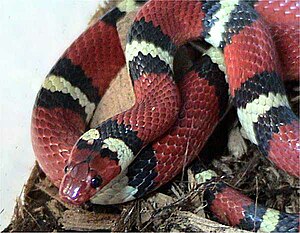Lampropeltis elapsoides
| Lampropeltis elapsoides | ||||||||||||
|---|---|---|---|---|---|---|---|---|---|---|---|---|

Lampropeltis elapsoides |
||||||||||||
| Systematics | ||||||||||||
|
||||||||||||
| Scientific name | ||||||||||||
| Lampropeltis elapsoides | ||||||||||||
| ( Holbrook , 1838) |
The red king snake ( Lampropeltis elapsoides , Syn .: Lampropeltis triangulum elapsoides ), also scarlet milk snake , is a non-poisonous and strikingly marked type of king snake living in America . The red king snake, which remains small, often only grows between 35 and 50 cm. The largest snake of its kind was measured at 27 inches (68.5 cm).
distribution and habitat
The occurrence is limited to the states on the east coast from Florida to New Jersey. The animal is a nocturnal ground dweller, prefers slightly damp habitats and can still be found at heights of 2450 m.
nutrition
In addition to lizards, there are also small rodents on the menu. Since the entire Lampropeltis complex also feeds on ophiophagus, the red king snake also eats smaller snakes that occur in its range. The prey is fixed with a bite and then wrapped around, whereby the breathing and often the blood circulation of the prey is prevented. Small prey such as B. nest rats and mice are packed and swallowed alive.
Reproduction
After successfully mating, the red king snake lays 2–9 eggs. The 7.6 to 8.8 cm long neonates hatch from May to August.